On Friday, I volunteered to lay wreaths at a National Cemetery near my home. Driving past part of the cemetery to go to the entrance, I spotted a Model A blind back sedan in attendance at a funeral. Circumstances prevented me from heading over to see it directly, and it was long gone by the time I got there. In those surroundings, the car made an impression on me. All these years later, the Model A still has a simple, dignified presence. The styling is elegant and perfect, yet it was considered an economy car. The combination of Edsel Ford’s eye for beauty and his father’s knack for simple but durable engineering created an icon that is as American as baseball and apple pie. Another stunning example of their genius is this 1930 Model A Sport Coupe, currently for sale on craigslist in Odon, Indiana. While the $15,900 price might be a bit out of tune with the falling Model A market, a bit of negotiation might put this stately coupe in your garage before New Years Day.
A Sport Coupe is a rather original body style. Designed to look like a convertible, but without the hassle of having a folding top, these were basically convertibles with non-folding canvas tops and full frame doors with roll up windows. They even came with non-folding landau bars to complete the convertible look. One of the original six body styles that the Model A debuted with, these were a popular option for those who wanted a sportier looking body than the standard coupe.
Another unique aspect of these cars is that the back window assembly is built into a canvas that can be unsnapped and rolled up to provide flow through ventilation or conversation with the passenger or passengers in the brown artificial leather clad rumble seat. Some folks called these “mother in law seats,” and I think you can see why. On those days, the canvas window assembly would certainly be snapped down.
This particular Sport Coupe is advertised as an older restoration that is still in great condition. The seller states that the only problems with it are that there are a few chips and scratches, which is typical of an older restoration. They further state that everything works on the car down to the light for the instrument panel, and that the wheels have recently been powder coated and shod with new Firestone tires with, assumedly, new tubes. The steering box has also been rebuilt, which can do wonders for a car this age. Often, older steering boxes are painted and ignored during restorations because they still work. However, they are usually caked up with hardened grease over years of neglect, and flushing that sludge out and making adjustments can go a long way towards making an old car like this more pleasurable to drive.
Inside, everything looks to be neat and tidy, but with some waviness in the door and kick panels. One of the big dilemmas with upholstering an older car is the price of being 100% period correct. Lebaron Bonney, long considered the industry leader in providing correct upholstery for early Fords, has this car listed as needing either a brown check wool broadcloth if the car was produced from January through early April of 1930, or a grey check wool broadcloth if produced from later April through December of that year. Neither the pattern nor the color of the cloth from LeBaron Bonney match what is in the car, but the LeBaron Bonney upholstery package, which covers every soft surface from top to carpet and seats to rumble seat, runs a pricey $3,010 plus oversize shipping. At prices like this, the temptation to have a car upholstered at a local shop in good looking and durable, but factory incorrect, cloth at a lower price is understandable and warranted in all cases except for the most exacting restorations. The interior in this car looks fine, except for the waviness, and is perfectly acceptable for a car that will be driven and enjoyed.
Under the hood, we see the standard Model A engine, but with a few small modifications to enhance drivability. The owner claims that the engine is “factory rebuilt,” but the most obvious improvement in this picture is an alternator replacing the standard generator set up. One of the dilemmas facing restorers of all prewar and many postwar cars until the mid 1950s is the decision to retain the original six volt electrical systems, or upgrade to a twelve volt system with a modern alternator. Faster starting, brighter headlights, being able to use and charge modern portable electronics such as GPS systems and cell phones, and enhanced reliability are all enticing reasons to upgrade to twelve volt electrical systems. However, they make six volt alternators, which this car has, and the standard electrical systems are not that bad when properly set up and maintained. After all, many decades passed before twelve volt systems were available, and people managed to drive these cars all over the place. Just ask the Okies.
In this photo of the passenger side of the engine, we see that a heat shield has been installed to protect the ignition system from exhaust manifold heat. Also, a plastic inline fuel filter has been added to catch sediment on its way to the carburetor. Usually, there is a filter in the glass bowl on the cowl to collect sediment from the fuel tank, but it seems to be absent. Given that this car is an older restoration, my guess is that it has been dormant for quite a while, and the gas tank is a bit gummed up. The plastic fuel filter is a good way to catch any filth before it plugs up the carburetor. Just watch out for spraying gas on the exhaust manifold if the car is warm. Given that the fuel is delivered by gravity rather than a fuel pump, there is enough fuel between the fuel cut off at the dash and the fuel filter to cause a pretty nasty fire.
In all, the price might be a little higher than the market will bear, but you’d be hard pressed to restore a Model A yourself and come out at a lower figure. This has all the signs of being a car meticulously built up for touring, but has been otherwise restored to a fairly high standard. Once you got past the issues associated with long term storage, this is likely a car you could drive from coast to coast, albeit at 45 mph, with little trouble. While the person who restored this car is probably gone on to their reward, they have left behind a really solid, appealing Model A that can provide decades more enjoyment to a new owner. Wouldn’t it be nice to start the new year with a Model A smiling back at you in your garage?
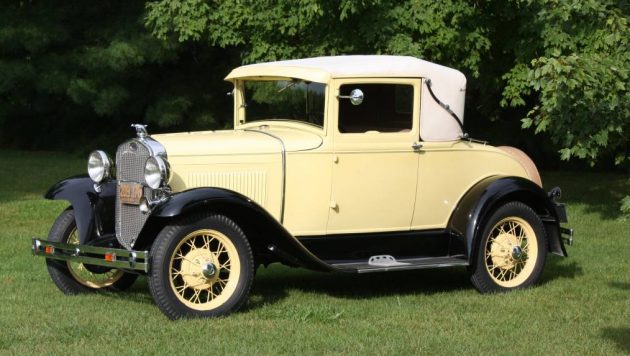

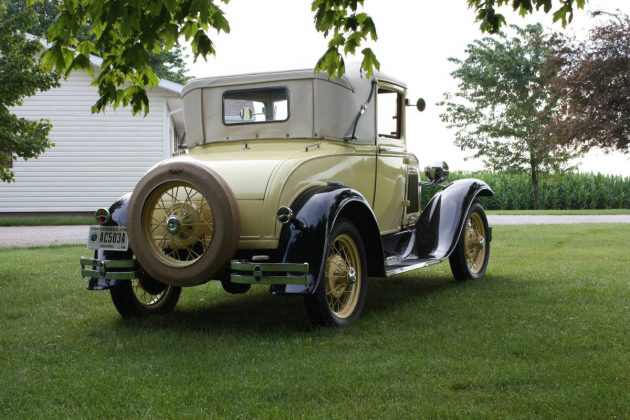
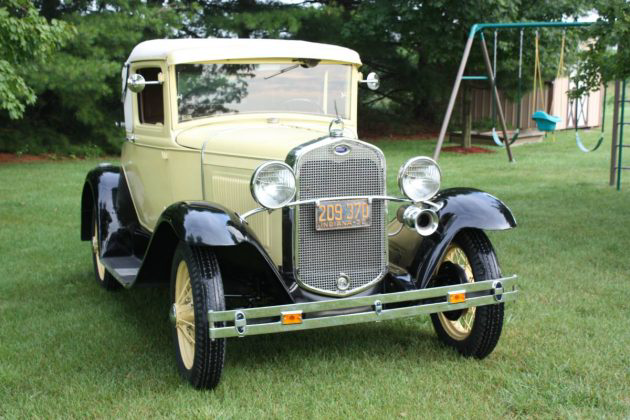
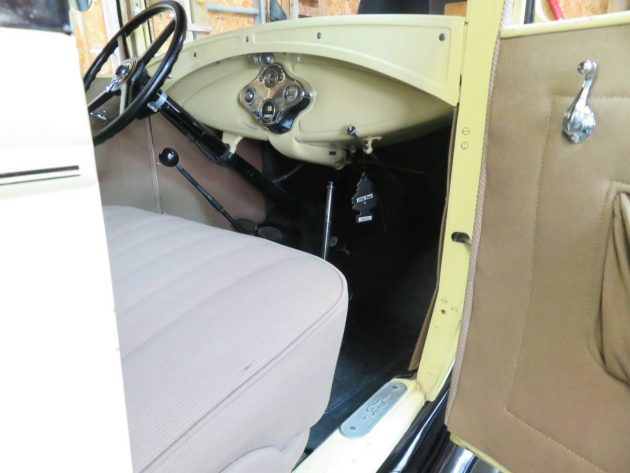
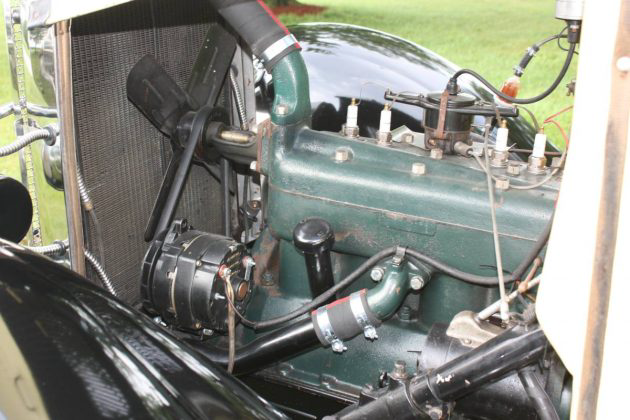


Model A’s always make me smile, something I’d like to own someday. Nice car.
Sport coupes had folding tops……..
Cabriolets had folding tops and roll up windows with no door frame. Sport Coupes such as this one had non folding canvas tops and the same doors as a standard coupe.
One of the best improvements one can make to a Model A that will be driven on modern roads is to convert to a modern 5 speed transmission. I did this some years ago and the difference was absolute magic. There was a conversion kit available back then and I assume kits are still around for the excellent Borg Warner 5 speed box. Be warned however that it was not an easy conversion but once done, it is almost undetectable unless you look underneath the car and it is a real pleasure to use.
Do this, and you’d better upgrade to juice brakes.
Yup! That’s true but a lot depends on how you drive it too.
First 12 volt system: Dodge, 1914. Changed to 6 volt system in 1926 due to industry pressure and consumer ignorance.
This Model A is very typical of older amateur restorations. There are many out there like this one. The laws of supply and demand are still in force, so get your Model A today!
I have a 1929 Model A Sport Coupe which looks very similar to this one which I purchased off Ebay in September for $14K.
I love mine and think the price was fair. As Jeff indicates, this is a buyer’s market. I was actually looking for a four door and still might in the market if the right one for the right price knocks on the door.
The Ford Model A Club of America, the local chapters of FMACA, and the Model A Restorers Club are made up of some of the finest people you will ever meet in the automotive enthusiast world.
@Lawrence: The Sport Coupe soft top does NOT fold down — Jeff’s description is correct.
The plastic fuel filter is dangerous.
Nice car! Should make the new owner very happy. I’ve heard numerous comments in the past on converting to juice brakes. Mechanical brakes are nothing to be afraid of. Properly maintained, mechanical brakes can haul cars like this down with no problems at all. One thing I would consider though is using a ‘B’ crankshaft. It smooths that engine right out, and you can easily add another 10 mph to your cruising speed.
Thank you for taking the time to lay down a wreath for each veteran. Each one is much loved Father, Brother, Husband, Wife or other relative of a person who served. Seeing the wreaths and reading headstones about their life and service is a sobering moment. My father-in-law, a great man who lived his life with kindness and integrity, was interred on the day the wreaths were placed. Your effort is much appreciated by those of us who visit and see this beautiful tribute.
And may I second that emotion. As a career combat veteran,
I too appreciate your taking the time Jeff, to honor those who have fallen, sacrificing their lives so we could live ours in freedom.
The landau bars on the car for sale are on backward, right on left and left on right
See pic of 29 in comments to see the correct installation
Sorry…just thought I’d seen a coupe door’d – folding top A over time….wasn’t an A-400 but like a sport coupe I thought…..I have a 68-B….
When I saw this I was reminded of my late dad who was always saying he would like to have a ’30 or ’31 Model A roadster but he said it would have to have the cowl lights that were an option on those,although this is a sport coupe rather than the roadster it does have the rumble seat which he also mentioned,these are very simple cars to drive and maintain,just wish I could afford it (sigh)